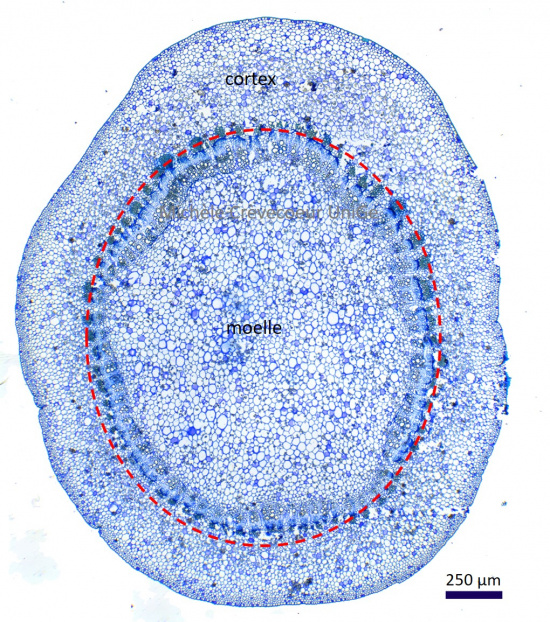Cross section through a stem of Pereskia grandifolia
Pereskia grandifolia, Pereskia with large leaves is a cactus from Cactaceae family, native to countries in Central America, South America and Mexico. It is a succulent plant with thick and fleshy leaves. It is one of the rare cacti with persistent leaves. Stem and twigs are covered with long, pointed black spines, a characteristic exploited in some part of Brazil to use this shrubby cactus as fencing.
Pereskia grandiflora is also called “rose cactus” a name due to the numerous pink to purple flowers appearing in early spring and last throughout the summer. The flowers look like rose hips flowers.
Micrographs on this page illustrate a cross section through part of a stem fixed with FFA and embedded in paraffin. Sections were stained with toluidine blue.
General aspect of the section with characteristics of a dicotyledon young stem: extensive central pith (medullar parenchyma), a single ring of vascular tissues (red dotted lines; Fv) and the cortex constituted of parenchyma cells (cortical parenchyma).

Below part of the section at higher magnification. From outside towards inside: uniseriate epidermis (ep); cortical parenchyma (pc); fibers (f) covering vascular bundles with xylem (x) and medullar parenchyma (pm). Red arrows indicate starch grains in amyloplasts of both cortical and medullar parenchyma.

Part of the section with uniseriate epidermis and its relatively thick cuticle, polygonal cells of cortical parenchyma (pc) with thin walls. The small intercellular spaces are well evident (arrows).

A vascular bundle with its different tissues: xylem (x) towards inside; phloem (pl) towards periphery of the stem and patches of fibers (f) with thick lignified walls (f). Starch grains contained in amyloplasts Les grains d’amidon des cellules de parenchyme cortical are well apparent.
